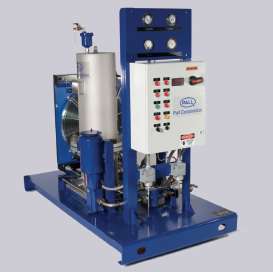Power Company melhora a confiabilidade da turbina a gás removendo o 'verniz'
Produto: Sistema de remediação de verniz VRFII
Aplicação
Uma empresa de geração de energia com sede no Colorado, EUA, operando uma turbina a gás GE Frame 7A em um ciclo simples, enfrentou problemas de verniz em sua usina. Um aumento constante dos níveis de verniz no óleo lubrificante, revestindo componentes críticos do sistema, identificados durante o monitoramento de rotina do sistema de lubrificação da turbina.
O sistema de lubrificação da turbina com capacidade de 6.200 litros usando óleo lubrificante ExxonMobil TerresticTM ISO 32 estava em serviço há aproximadamente 48.000 horas durante um período de 7 anos e protegido por filtração de linha de retorno nominal de 5 µm de marca desconhecida.
A Classificação de Potencial de Verniz ou VPR℠ (ou seja, a probabilidade potencial de tendência de um lubrificante para formar depósitos de verniz) foi medida através do método de colorimetria de adesivo de membrana e encontrada em um nível de 85, indicando um alto nível de produtos de degradação de óleo insolúveis associados com verniz, além do limite 'crítico' do operador. O tratamento imediato do óleo foi recomendado para retornar o óleo às condições normais de operação recomendadas.
A solução de remoção de verniz do óleo de turbina da Pall
Uma unidade de remediação de verniz Pall VRF foi implantada em uma configuração de alça renal. O skid usa um resfriador para manter a temperatura ideal do óleo para a remoção mais eficiente do verniz do óleo lubrificante antes de passar o óleo através de um meio adsortivo especialmente projetado, otimizado para a remoção de precursores formadores de verniz do óleo. Na saída, o óleo flui através de um filtro antiestático com tecnologia Pall SRT, classificado em ß12(C) ≥ 1000 para proteção adicional e melhor limpeza do fluido, antes de retornar ao reservatório principal.
Resultado
Foi observada uma melhora imediata no VPR℠, caindo de 85 para 38 (dentro dos limites normais recomendados) em menos de uma semana. Com um fluxo de 11 GPM, várias passagens do fluido do sistema através da unidade VRF durante um período de mais 4 semanas retornaram o fluido a um VPR de 11 com sinais insignificantes de verniz nas membranas de teste tomadas durante o tratamento.
O revestimento de verniz macio nos componentes e caminhos de fluxo também foi arrastado de volta para o fluido e removido. Testes realizados para avaliar o efeito dos aditivos de fluido depois do tratamento do fluxo de refrigerante variável sem alteração do conteúdo de aditivo entre o fluido não filtrado que foi filtrado >20 vezes, sugerindo que o material filtrante do fluxo de refrigerante variável não teve efeito adverso notável no fluido.
Como um dos contribuintes conhecidos para a formação de verniz é a descarga eletrostática induzida por filtros de óleo, também foi recomendado que a planta utilizasse meio antiestático com grau AN (Beta 7(c) = 1000) tecnologia Pall SRT que utiliza meio de filtração dissipador de carga eletrostática.
Para obter mais informações sobre a remoção da ameaça de verniz de seu sistema de lubrificação da turbina antes que cause inatividade do sistema, entre em contato conosco na Pall.
Para saber mais sobre como melhorar a eficiência de seus processos, contate nossa equipe de especialistas em filtração.

